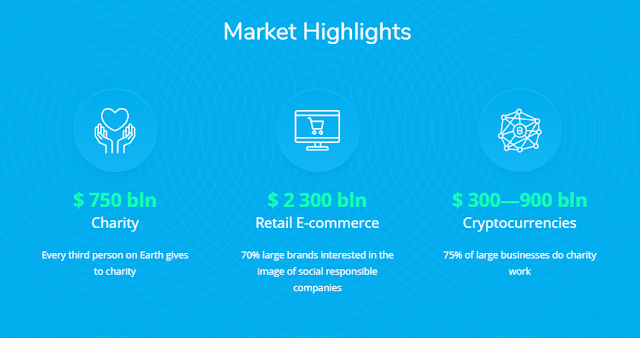Charity
market
Every third person on
Earth gives to charity at least once per year, with 50% of donors providing aid
to strangers according to the World Giving Index 2017, compiled annually by the
Charity Aid Foundation. For the third consecutive year, charities have raised a
record volume of funds. In the US alone, the amount of recorded donations
reached $400 billion. About three-quarters of the country’s residents have
helped a stranger at least once, and two-thirds have donated money to multiple
charity foundations. The volume of donations in the US consistently exceeds 2%
of the nation’s GDP; around 7 new charitable foundations are created every
single day, with more than 1.5 million currently in operation across the
country.
In other countries, too,
charitable donations represent a significant proportion of the overall economy.
In Europe, the British have the largest number of philanthropists, and
according to various data sources: 70% of the country’s residents transfer
money to support humanitarian projects. Germany, Japan and France are also
among the countries where the population actively engages in donating money to
charity. The Mohammed bin Rashid al Maktoum Foundation, one of the largest
charitable organizations in the world, is based in the UAE.
According to the Charity
Aid Foundation, private individuals are the most active donors. Traditionally,
their contributions account for up to 80% of all donations, with crowdfunding
rapidly evolving. Around 15% of all donations are through foundations, with
large corporations accounting for only 5% of donations.
People donate money more
often and more readily to religious causes (32% of the collected money);
education (15%); humanitarian aid (12%); charity fund projects (11%) and
healthcare (8%). An additional 22% of donations account for other purposes,
including environmental protection, protection of wild animals, as well as
culture, art and international projects.
E-commerce
market
According to Statista, the global online commerce
market is set to reach $4 trillion in 2022, while e-commerce retail sales hit
$2.3 trillion in 2017. The retail landscape is rapidly changing and according
to a Pew Research Center poll, currently, 8 out of 10 Americans are active
online buyers.
Market leaders, such as Alibaba, have already started
implementing blockchain solutions. Retailers will use cryptocurrencies for
payments, in particular through integrating tokens into consumer loyalty
systems. Expedia, one of the world’s largest travel agencies, and Zynga, a
major computer game developer, began accepting cryptocurrencies as early as
2014.
Problem
E-commerce market
High competition in the e-commerce segment puts
pressure on players to develop new loyalty programs not only to attract new
customers but also to retain existing ones by offering a variety of discounts
and benefits. The most pressing challenge for marketing professionals is to
create an emotional attachment. New loyalty programs are constantly appearing
on the market, and while the overall idea behind them is sound, among the
avalanche of new information that hits us daily, it is becoming more and more
difficult to engage consumers at an emotional level.
A survey conducted by Nielsen group, found that 50% of
consumers, surveyed worldwide, would be willing to pay more for goods and
services from socially responsible companies.
Solution
E-commerce market
The integration of consumer loyalty programs with the
charity industry will create a strong emotional resonance. The future of online
retail lies in being able to completely personalize each offer, and blockchain
is one of the main stimuli for this further development.
Information
ICO -
Token HUMA
Price 1 HUMA = 0.01 USD
Bonus Available
Bounty Available
Platform Ethereum
Accepting ETH
Soft cap 6,000,000 USD
Hard cap 26,000,000 USD
Country UK
Token
mining. Proof of Charity
Even a modest 1% of the charity industry turnover
accounts for 25 times more than the number of Humancoin tokens issued at the
Token Sale. Therefore, in order to provide further rewards to benefactors, the
company will issue additional tokens after the Token Sale, in strict
correlation to the actual amount of funds raised on the platform.
The platform's smart contract will grant additional
issues of tokens in limited tranches (1 billion tokens each), which will depend
on the volume of funds raised and are based on the need to reward benefactors
in proportion to their donations. New tokens for other purposes, apart from
rewarding donors, will not be issued.
Proportional to their donations, benefactors receive
back 50% of the value of their donation in tokens, according to the
exchange-weighted price of the token (in other words, benefactors “buy” or
“mine” tokens at the rate of 2x to the price listed on the exchange). For
example, a patron donates the equivalent of $1,000 to charity projects on the
Humancoin platform. If the average exchange rate of the Humancoin token is, for
example, $2, the donor is credited with 1000/ (2×2) = 250 Humancoin tokens.
Token holders will be able to sell their tokens on
cryptoexchanges or keep them for benefits in the ever-growing partner network.
All tokens exchanged for benefits from e-commerce partners on the platform will
be taken out of circulation and burned.
The Proof of Charity concept allows the project to
scale hundreds and thousands of times and, therefore, places no restrictions on
the number of participants that can get involved: new projects, donors and
e-commerce market players will be able to become part of the Humancoin
community in the future.
CONCLUSION
HUMANCOIN serves as one
of the best platform that helps to transform the charity organization through
decentralized platform, we have put in place the necessary things to solve the
problem and our model stands out clearly to help solve the problem of third
parties involvement which has led to development of doubt in the industry.
More
Information:
Website : https://www.humancoin.net/
Ann Thread : https://bitcointalk.org/index.php?topic=4469466
Twitter : https://twitter.com/humancoinnet
Telegram : https://t.me/HumancoinChat
My Profil Bitcointalk : https://bitcointalk.org/index.php?action=profile;u=2183815;sa=summary



Comments
Post a Comment